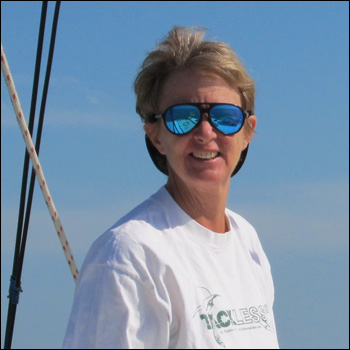 All my Admirals agree that there are basic boat skills all cruising women should know, not simply to increase their confidence, but to cover their butts should something happen to the captain. You won’t be in the cruising world long before you hear the story of the cruising wife, who, when the husband fell overboard, didn’t know how to turn off the autopilot. She not only could not stop to retrieve him but eventually rode the boat onto shore. You might think this is apocryphal, but, sadly, it happens over and over.
All my Admirals agree that there are basic boat skills all cruising women should know, not simply to increase their confidence, but to cover their butts should something happen to the captain. You won’t be in the cruising world long before you hear the story of the cruising wife, who, when the husband fell overboard, didn’t know how to turn off the autopilot. She not only could not stop to retrieve him but eventually rode the boat onto shore. You might think this is apocryphal, but, sadly, it happens over and over.
So, at the top of the list are emergency procedures starting with how to turn off that autopilot, preferably followed by all the steps to execute a successful man-overboard recovery. Practice of this skill, under sail and under power and on your own boat with your own gear, will take away the single biggest anxiety on the minds of most cruising women (as it ought to do for male captains…only they never imagine they’ll go overboard.) Yet it is rarely practiced. Too much bother to free the man-overboard pole from where it’s jammed in, bring the boat around, drop the sails, get the LifeSling wet. And God forbid you should push the MOB button on your GPS; it’s a bitch to get turned off. Hey, I’m not pointing fingers. I can’t remember the last time we practiced on Tackless II. Tomorrow, honey.
Probably the next important skill is knowing how to use your radios, in particular to call for help. You may already know that VHF 16 is the emergency and hailing frequency, but when offshore out of VHF range do you know how to use your SSB? There are many good radio books, but one I like is Marine SSB Radio for “Idi-Yachts by (Ms.) Capt. Marti Brown. Marti will tame that glowing, squawking box into something you can use everyday to keep in touch with your widening circle of mobile friends (as well as those you left behind), and in Chapter Three she lays out everything you need to know about emergency calls. Copy down the official USCG format for Mayday calls, fill in all the specifics of your boat, and post it by your radios, so you won’t have to think when you can’t! If you are cruising in foreign waters, use the ready-made pages on emergency radio calls in Kathy Parsons’ indispensable Spanish for Cruisers and French For Cruisers
Even if you have taken all the sailing courses in the world, if your captain becomes unexpectedly unavailable, finding yourself in charge of your own boat the first time is a sobering moment. You must, essentially, singlehand. For example, it is more important for a suddenly-single hander to know how to reduce sail than to raise it. Learn how to take a reef (or two), furl the headsail to a handkerchief, set the staysail (especially if it is self-tending), or get rid of the sails altogether and start the engine You may want to get where you are going in a hurry, but making your boat “smaller” and less work will help you feel in control.
Next, you need to know how to get where you are going, i.e. navigate. In this day and age of GPS and electronic charting, this is much easier than it used to be, with point-and-click waypoints, tracks you can follow in or out, and a boat icon on the screen you can steer away from hazards. But like traditional navigation on paper charts, just having the tools does you no good if you don’t know how to use them. Take a Power Squadron navigation course. Admirals often end up being their boat’s primary navigator!
Lastly, when you anchor with your captain, you are probably either on the foredeck or behind the wheel. Get in the habit of switching places so you are comfortable both with the principles of handling the boat when setting or retrieving the anchor as well as operating the windlass and “man”-handling the anchor at the roller. Then formulate a plan for doing both by yourself, and practice in different conditions.
Emergencies will hopefully never happen, but are emergency skills ones you’ll never use? Hardly! Every one of the above skills can be something you use every single day you are cruising …even the MOB drill….for the ball cap your captain loses overboard!
This article was published in the November 2006 issue of Latitudes and Attitudes.
Related articles (on this website)
- The Need to Know (Admiral’s Angle column #17 )
- Getting Started (Admiral’s Angle column #3 )
- How We Learn – Women tell us how they have learned the skills they need to sail and cruise (Women and Cruising blog)

Great article, thank you again for wtrinig.